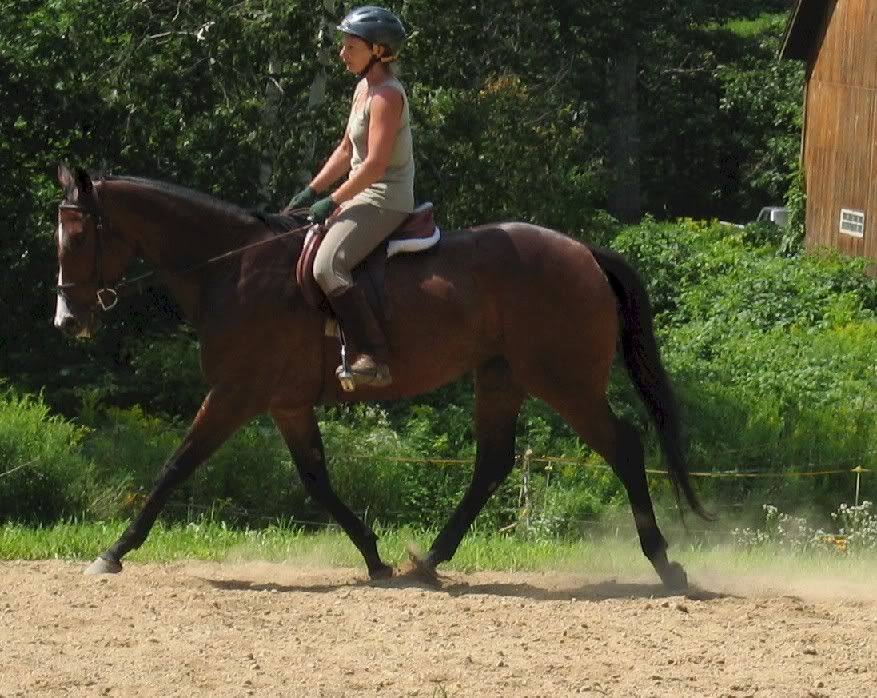|
|
Post by whatsnottaken on Aug 4, 2010 20:33:42 GMT -5
So Mister took a nap in what must have been a tick nest(?) Originally, on Saturday, he came in with a bunch of what appeared to be ant bites on the right side of his neck, shoulder and barrel/back. My barn manager and I checked out the bites, and did not see anything in them so we figured it must have been ants, which we have found a few nests at the new farm.
He got some Azium (dexamethasone), and I figured we would just have to ride it out until the swellings went down and healed. Fast forward to today when I bring him in to groom him, the bites are starting to spread into little welts, but each one has a teeny, tiny white speck in the middle of it. Each of the little specks is literally smaller than the head of a pin. They are the tiniest ticks I have ever seen. As of yesterday, they had not swollen up yet, and today they were just big enough to see.
I pulled off as many as I could find and sprayed him liberally with fly spray before I put him out. I checked his temperature for a baseline (100 is his norm) so I can keep an eye on that over the next few days. He is still pretty touchy, understandably.
I am wondering, though: since the ticks were so small, were they just hatched? If so, are ticks hatched carrying Lyme disease, or do they have to pick it up from something else first? I am also wondering if I should put him back on dex until the welts are gone or if there are any other steps I should take. I will probably get a snap test or titer done in a week or so, just to make sure. I'm a little freaked out about the whole thing, and hoping to dodge the bullet of having to treat Lyme.
|
|
|
|
Post by mes on Aug 4, 2010 21:11:05 GMT -5
Deer ticks are tiny like that. Most people who get Lyme don't even see the tick that gave it to them because the tick is that tiny. I hate Lyme. I use a spot on product to prevent ticks. I checked the risk map and it appears VA has a low risk for the disease. Depending on where you live, you either have a Low Risk or Minimal to No Risk. www.wildflorida.com/articles/Ticks_in_Florida_Deer_Tick.php |
|
|
|
Post by whatsnottaken on Aug 4, 2010 22:24:20 GMT -5
Unfortunately, there seems to be a higher incidence of Lyme in Northern VA, and I know both people and horses that have contracted it locally. I am very unhappy with myself that I missed the ticks for so long.
|
|
|
|
Post by BoyleHeightsKid on Aug 5, 2010 7:02:15 GMT -5
Sounds like hives to me not tick bites.
|
|
|
|
Post by Deb on Aug 5, 2010 7:08:18 GMT -5
Deer Ticks, also known as Seed Ticks are very plentiful here this year, too. Since your aware of the tick problem on Mister you are ahead of the potential Lyme Disease. I know that with dogs and cats Sevin Dust can be put on them. Sevin Dust is a powered vegetable garden insecticide. I am not sure if it can be used on horses though.
|
|
|
|
Post by abowls on Aug 5, 2010 10:18:07 GMT -5
If you look at that map of lyme risk factor that mes provided, can you see that the border between MD and VA looks thicker than the other borders? That's us  . Where I live we actually have a very high risk and where my horse is and WNT's horse are is just a tiny bit south of where I live so still pretty bad. That SUCKS WNT. I don't know what deer ticks look like when they just hatch? Perhaps they are white when they are very little? Both DH and I have had adult deer ticks on us but they were black. I've found two on my belly and both times I remember thinking hmmm I have a new mole on my belly and then realizing that it wasn't a mole. They are that little. I doubt I would find one on Nate if he had one since it would be surrounded by a vast area of white like the ones on my belly were. I found this link about deer ticks. It seems that it would be the right time of year for deer tick larvae. It doesn't mention them being white though. It also specifically says that larvae are born uninfected, they find a host to feed on until they progress to the nymph stage. They apparently won't detach until ready to molt into a nymph so the website says that they aren't a danger to us since they would not be infected when attaching and won't detach until they are ready to change into nymphs. Does your flyspray say that it protects against ticks? I keep coating Nate with Bite Free partially b/c it's the best I've found for both gnats and regular flies (nothing seems to work for horseflies  ) and partially b/c it says that it keeps ticks away. I don't know for sure that it helps against the ticks though. www.aldf.com/deerTickEcology.shtml |
|
|
|
Post by Smay on Aug 5, 2010 15:52:32 GMT -5
I'd say to go on COTH and ask people about it from your area. I don't think there's such a thing as "tick nests" and a horse lying down wouldn't get a "patch" of ticks I don't think. So he may have been bitten by something else. But anyway, the best thing I've found to repel ticks is the spot-on treatments that you dribble down the crest of their neck and in the dock of their tail and on their fetlocks. This repels ticks for a GOOD long time, and keeps them from crawling up the long hairs and embedding in their favorite locations - the mane and tail.
|
|
|
|
Post by whatsnottaken on Aug 5, 2010 20:56:42 GMT -5
Found a really interesting article that gives me some reason for hope: www.aldf.com/deerTickEcology.shtmlThe description of the deer tick larval stage is spot on the buggers I found on Mister. The only reason I found them is that they had been embedded since Saturday, filled up and became big enough to see (entering the nymph stage, I guess). It definitely wasn't hives, in the classic sense, as each lump had one of the little %@$+@{%$ smack dab in the middle of it. Anyway, it does say that tick larvae have to pick up Lyme, or any of the other diseases the @$#% things carry from its first host critter. If that is the case, I think he's safe. Since I got the ticks off, the bite welts have decreased rapidly in size. Hopefully he will be okay to ride again this weekend. Ah, Virginia summers: heat, humidity, bugs, what more can one ask for? |
|
|
|
Post by Smay on Aug 6, 2010 14:46:48 GMT -5
Oh man, that IS kind of good news then! The "baby ticks" can't have carried Lyme from anywhere, even if he DID have a bunch of them on him? So he just has a bunch of disgusting little baby ticks and the accompanying lumps? Poor guy! But at least no Lyme Disease!
|
|
|
|
Post by jenarby on Aug 6, 2010 21:26:45 GMT -5
I remember pulling them off of dogs when I worked for a vet. They looked like little sesame seeds (hmmm...want a burger now??). I use that Freedom 44 spot treatment on my horses. You can buy it at tractor supply. The package says each tube lasts for 2 weeks but I've stretched it as far as 4 weeks and had no problem. If you make sure the pastures are mowed low that helps too. The adults like to climb to the tops of tall grass and grab onto mane hair and tails.
Ick...I hate creepy crawlers....giving me the itches thinking about them!
|
|
|
|
Post by Katelyn on Sept 5, 2010 19:06:10 GMT -5
Eww...I've had lots of luck with the Spot-On stuff, too. If I was you, I'd put a blob of petroleum jelly on each welt...apparently, the ticks can't breathe and will let go - ?? - Since we got Guinea Fowl, we've had NO trouble with ticks! If you're in a bad area, might not be a bad idea to get a couple (IF you can stand the noise!  ) |
|
|
|
Post by niaru on Sept 11, 2010 8:07:44 GMT -5
Yes around here in bug-infested New England Guinea Fowls are a known "tick remedy" as well as spot-on treatments for all critters (cats, dogs, horses).
Charm is on a dry lot (very little grass) so no tick anxiety for me unless we go work in the fields or trail riding. Then I spray her legs and belly with Bite Free.
I hate ticks. There are trails/woods in my town that I don't even take my dog to anymore, even if she has Frontline on.
All the best to Mister!
|
|
|
|
Post by whatsnottaken on Sept 14, 2010 18:45:44 GMT -5
We haven't had any problems since then, and so far no grown ticks right now. I will still be keeping an eye out as we get into October and November, but hopefully no more weird tick issues!
|
|






 . Where I live we actually have a very high risk and where my horse is and WNT's horse are is just a tiny bit south of where I live so still pretty bad.
. Where I live we actually have a very high risk and where my horse is and WNT's horse are is just a tiny bit south of where I live so still pretty bad.  ) and partially b/c it says that it keeps ticks away. I don't know for sure that it helps against the ticks though.
) and partially b/c it says that it keeps ticks away. I don't know for sure that it helps against the ticks though.


 )
)
